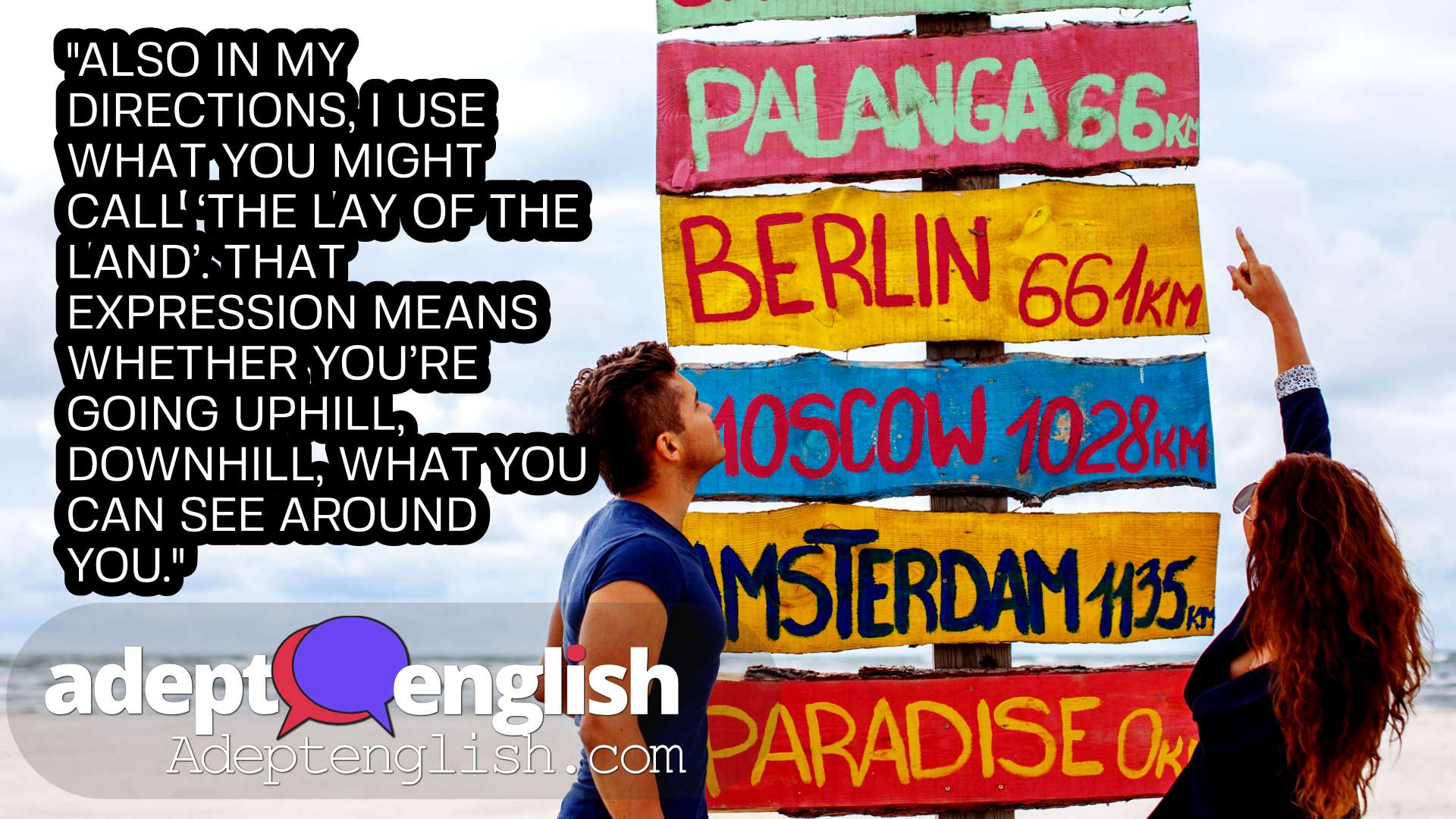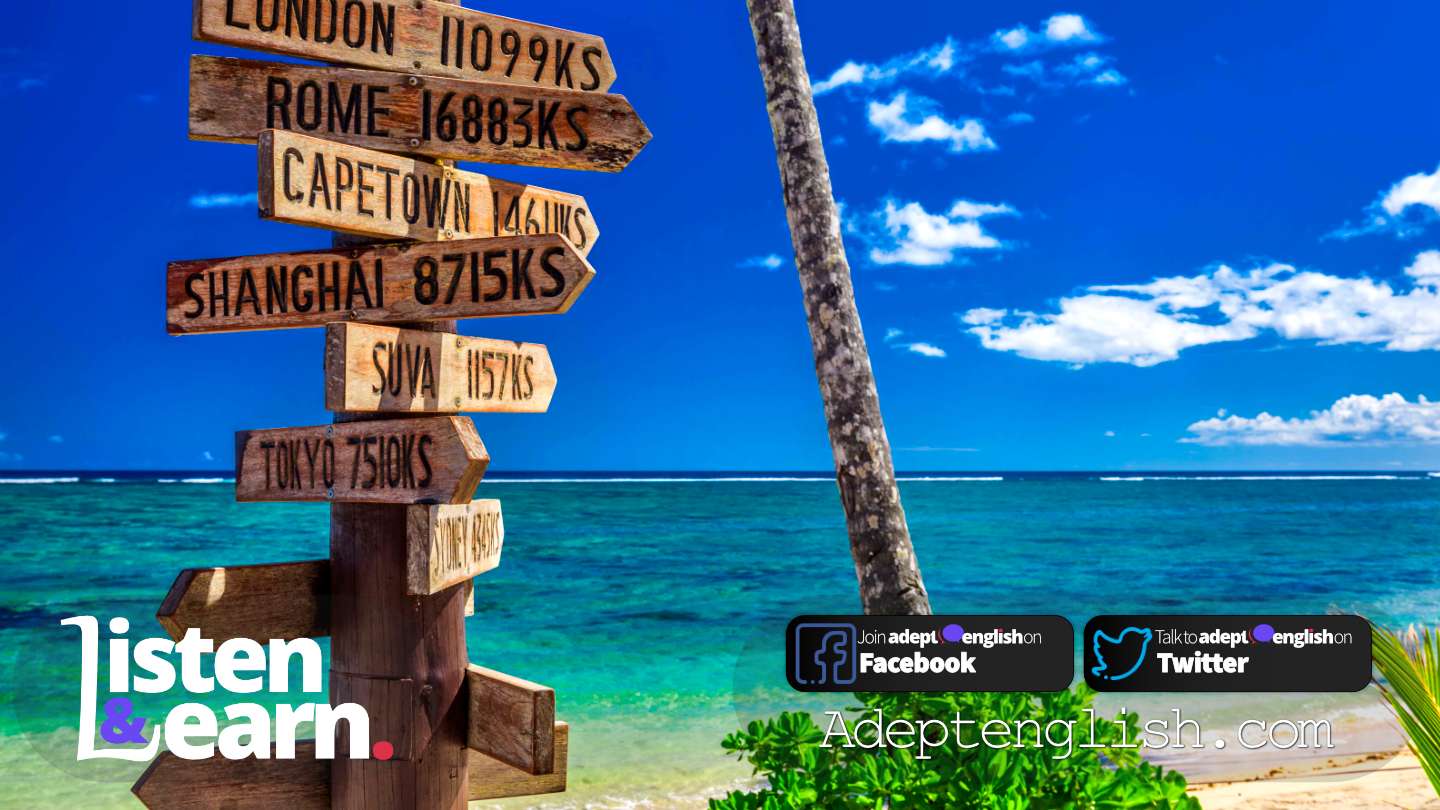Learn English conversation, direction vocabulary, and navigation skills in British English
English conversation about the language of finding your way and giving directions in the UK. You're in the UK it’s morning and you want to go to Starbucks for a coffee. You fire up your mobile phone and have found a map of the area and it’s all good; you have planned your route. But soon enough, your Sat-nav map tells you have reached your destination but no Starbucks! And then it happens, your phone’s battery dies. This is where things can get tricky. How do you ask for directions in a foreign language?
Mobile phones are amazing these days, with apps, and maps that can help you travel the world. However, sometimes your phones dead or you don’t have a signal. You need to know where you should stand for a specific bus, or to walk the path with the best views and you just need to ask someone for help.
Giving and taking directions to help navigate requires some unique English vocabulary, and people expect conversations and instructions to be given specifically. In today’s English podcast conversation, we talk about UK specific language and techniques for directions and navigation.
Truck drivers are great with directions. Landmarks, road conditions, the works. The only problem is that they’ll give you five different routes to just get to the next town. By the time they’re done, you won’t know what the hell to do.
⭐ Foster Kinn
A whole new world is opening up for you as a language learner. You’ve taken a giant step into a new world, and with that step comes new challenges to face. Learning how to travel successfully is one of those challenges. This lesson is going to help you on your way as you learn how to ask or give directions in English. Whether you’re on foot, bicycle or even in a car with Sat Nav/maps, this lesson will help.
Most Unusual Words:
Passer-By
Instructions
Directions
Amber
Uphill
Residential
Cul-De-Sac
Yards
Most common 3 word phrases:
| Phrase | Count |
|---|---|
| To Speak English | 3 |
| Please Could You | 2 |
| In The Street | 2 |
| By For Directions | 2 |
| A Passer-By | 2 |
| Support Adept English | 2 |
| You Listen To | 2 |
| You Want To | 2 |
| One Of Our | 2 |
Listen To The Audio Lesson Now
The mp3 audio and pdf transcript for this lesson is now part of the Adept English back catalogue . You can still download and listen to this lesson as part of one of our podcast bundles.Transcript: Learn British English Conversation And Vocabulary On How To Give And Take Navigation Directions
Hi there and welcome to this podcast from Adept English. If you’re enjoying our podcasts and you want to show your support, for Adept English then if it’s possible for you to give us a review or a star rating on the platform where you listen to our podcast – then we’d be really pleased if you could do that for us. Otherwise, you can support Adept English by buying one of our courses – for example Course One Activate Your Listening for English conversation practice – or one of our many, many podcast bundles. Lots of ways to support Adept English – and a big thankyou to all of you who’ve shown your support already!
Boost Your Learning With Adept English
How to learn to speak English giving directions?
How to learn to speak English and give directions? In the street, I mean. If you ‘give directions’ it means that you instruct people which way to go – to find a place. And if you ‘ask for directions’, it might be ‘Please could you give me directions to the nearest supermarket?’. Or ‘Please could you tell me the way to the police station?’. Or ‘I’m looking for a hairdresser’s – is there one on this road?’
What strategies do you employ to navigate?
So if you listen to Adept English podcasts, your English is probably already quite good. So you can probably ask the right question, in terms of what you want to say. So like the examples I’ve just given you – you’ll have a place in mind, that you’re trying to arrive at, and you stop and ask a passer-by for directions. A ‘passer-by’ – that’s PASSER-BY. That’s just someone ‘passing by’ in the street, a person.
People perhaps don’t stop passers-by for directions as much nowadays as we’ve all got directions on our phones or we research what the place before we set off, online perhaps. If we’re in the car, we’ll probably be using a satnav – the ‘satellite navigation system’ which tells us exactly where we’re going. If I’ve got to go somewhere new, I’m a big fan of Google Streetview. It means you can have a look! What does the road look like? What does the place look like? So when you get there, you recognise it.
Some people have a better ‘sense of direction’ than others. Some people have a really good instinct for direction and where they are, others not so much. So it’s often when you’re visiting a place, perhaps in a foreign country that you might need to understand and give directions in English. So you may think you know how to speak English well – but why not test yourself on understanding and giving directions?
Let’s practise understanding directions – listening practice
So let’s practise. Understanding first. I’ll give you some directions. These are the directions to my son’s school from my house. I’ve changed the names of the roads – but the directions are true. And these are directions for someone in a car. I’ll say it just as I’d say it to an English speaker. See how much of this you can understand.
‘OK, so you drive out of Wanborough Close and you turn left at the T junction. Very quickly you come to a mini roundabout and you’ll take the first exit, to the left. You follow this road around the bend and when you come to the second mini-roundabout, go straight on, second exit. Go down the hill and when you come to the junction with the main road at the bottom, turn left into Plymouth Road.
Video
Go along this road until you come to a big roundabout, with a motorway underneath. You then need to take the 3rd main exit off this roundabout, continuing on Plymouth Road. Stay on this road for about half a mile. Go straight through the traffic lights. Then you pass a petrol station on your right hand side. And there’s a veterinary surgery on the left, followed quickly by a bus stop, with a bus shelter and lay-by on the left. Take the left turn immediately after this into Longfield – and drive uphill.
At the top of this hill, you’ll come to a T junction – turn right into Oldfield Road and follow the road down the hill, through the left bend. Turn right at the next T junction and then….left at the one after that, which is Warfield Rise. Then when you come up to the main road, turn left into Cobham Way. You drive about 500 yards along this road – and you can see the turn for the school on the right hand side. You can’t miss it!’
Right! How to learn to speak English giving directions? Shall I help you some help now understanding the directions I just gave? I’m not expecting that you understood all of that – but once I’ve explained a few things, you can listen again to see how much more you understand, how much better your understanding is. Here goes.
Let’s practice understanding directions - explanation
So notice first of all my use there of what we call ‘landmarks’. A landmark, LANDMARK is something that ‘marks the land’. So typically we use landmarks to navigate by. So I’ve used lots of landmarks which are to do with the road – I mention a number of roundabouts and a number of T junctions. A T junction is where you come to the end of the road you’re on – and then you’ve the choice to turn left or turn right.
A roundabout – and we have thousands of these in the UK – possibly more than most other countries. A roundabout is a circular road, perhaps with grass or even trees in the middle, which has other roads coming off it. If you’re going over a roundabout, then we refer to the first road off the roundabout as ‘the first exit’ and the second off the roundabout as ‘the second exit’. Obviously, we are driving on the left in the UK – and so when you approach a roundabout in your car, you look right for oncoming traffic and you move left round the roundabout.
Again, we’re unusual – we go the opposite way around to most people in the world, anyway! I also mention ‘Go through the traffic lights’ – this doesn’t mean ‘go through while the traffic light is set to red’ of course, but rather ‘Go straight on at the traffic lights. So much of direction giving, especially if you’re in a car is ‘Go left, go right, go straight on’. And traffic lights – that’s TRAFFIC – they’re there to control the traffic at a junction. When the light is red you must stop. When it’s green you can go and when it’s amber, that’s AMBER another word for orange, you need to slow to a stop. And if red and amber show together, that means that the traffic light is about to turn to green.
Using landmarks when giving directions
Also in my directions, I use what you might call ‘the lay of the land’. That expression means whether you’re going uphill, downhill, what you can see around you. Notice the word ‘uphill’ – UPHILL. You might be tempted to pronounce that with a fff sound because of the PH together in the middle, but actually it’s ‘up-hill’ – it’s a compound or joined up word. That just helps the person know that they’re in the right place. And I also remark on things like ‘You pass a petrol station’ or ‘You see a veterinary surgery’ or ‘You can see a bus stop and a bus shelter’ – that’s the thing you stand in when you’re waiting for the bus and it’s raining.
Learn British English Conversation And Vocabulary On How To Give And Take Navigation Directions Ep 480 Article Image

📷
A photograph of people looking at a signpost. This English lesson will show you how to get there. It covers the vocabulary and key phrases for asking for and giving directions.
It has a little roof – that’s a bus shelter. And a lay-by – that’s when there’s an extra bit of road at the side to park in – so here the lay-by is so that the bus can stop at the bus stop, without blocking the road. And the final way in which I’ve given landmarks here, is in giving the names of the roads. So I’ve given you very typical British road names here – like ‘Plymouth Road’. Main roads are often called after distant cities or towns – and this usually indicates that this is an ancient road – the modern road tracks where the old, ancient road was, in the times of horses and carts, or perhaps even earlier than that. We have Roman roads of course, in Britain.
A famous one is ‘Watling Street’ – and my sister actually lives on Watling Street – her address is ‘Watling Street’, which is one of the straightest and longest Roman roads. We’re only 30 miles from London – so many towns in this area have a ‘London Road’ – and again there may be names like ‘Portsmouth Road’ or “Southampton Road’ or ‘Plymouth Road’ to reflect the destination of the ancient roads from old times. But there are also lots of ordinary residential roads in my directions – ‘residential’, RESIDENTIAL is an adjective and this means ‘roads where people live’, roads full of ‘residences’, which is another word for ‘homes’.
My road for instance is a cul-de-sac, CUL-DE-SAC – that means it’s a ‘no through road’, it’s a dead end. You have to turn round and go back the way you came to get out! So you can tell the road names because they have capital letters to show that they’re proper nouns – they’re names. Look at the transcript to help you, if you’re not sure about this. So ‘Wanborough Close’, ‘Plymouth Road’, ‘Cobham Way’, ‘Longfield’, ‘Warfield Rise’ – these are the names of roads. So they have capital letters. And the second word where there are two – like ‘Close’, ‘Road’, ‘Way’, Rise’ – these are typical British road names. You’ll also find ‘Street’, ‘Avenue’ or ‘Drive’ – these too are very common British road and street names.
Talking about distance when giving directions in English
What you may also notice is that a couple of times, I give an indication of distance. So I say ‘Stay on this road for about half a mile’ and later on, I say ‘You’ll drive about 500 yards along this road’. So it’s not just the driving on the left that you might find different. We also give our distances in miles, rather than kilometres. And for shorter distances, ones that you can see – we say ‘Oh, it’s 400 yards’ or ‘It’s a hundred yards’.
That’s ‘yards’, YARDS. And a yard? Well, a measurement of distance of course, but you might also buy fabric in the UK in yards – it’s a measurement of length. And a yard is the same as 3 feet or 36 inches. If that doesn’t mean anything to you, then drop us a message, send us an email – and I’ll do another podcast on what we call imperial measurements!
Your turn to give directions!
So play this podcast again and have another listen to the directions to my son’s school. As I said, these are genuine directions and I’ve said them exactly as I would to an English speaker. When you’ve listened to this podcast a couple of times, perhaps you can practise by talking to yourself – and actually giving the directions yourself. That’s always much more difficult than understanding directions.
Download The Podcast Audio & Transcript
Not quite as mad as it might sound talking to yourself – it’s great practice. What I suggest is that you think of somewhere you know well, near to where you live. And you then practise saying the directions to it in English, just as though you were explaining to someone how to drive or walk to that place. See how you get on! If you want to speak English without hesitation, this kind of practise is really good. And if you want to improve your English fluency generally, you can do this with Adept English.
Goodbye
Enough for now. Have a lovely day. Speak to you again soon. Goodbye.











